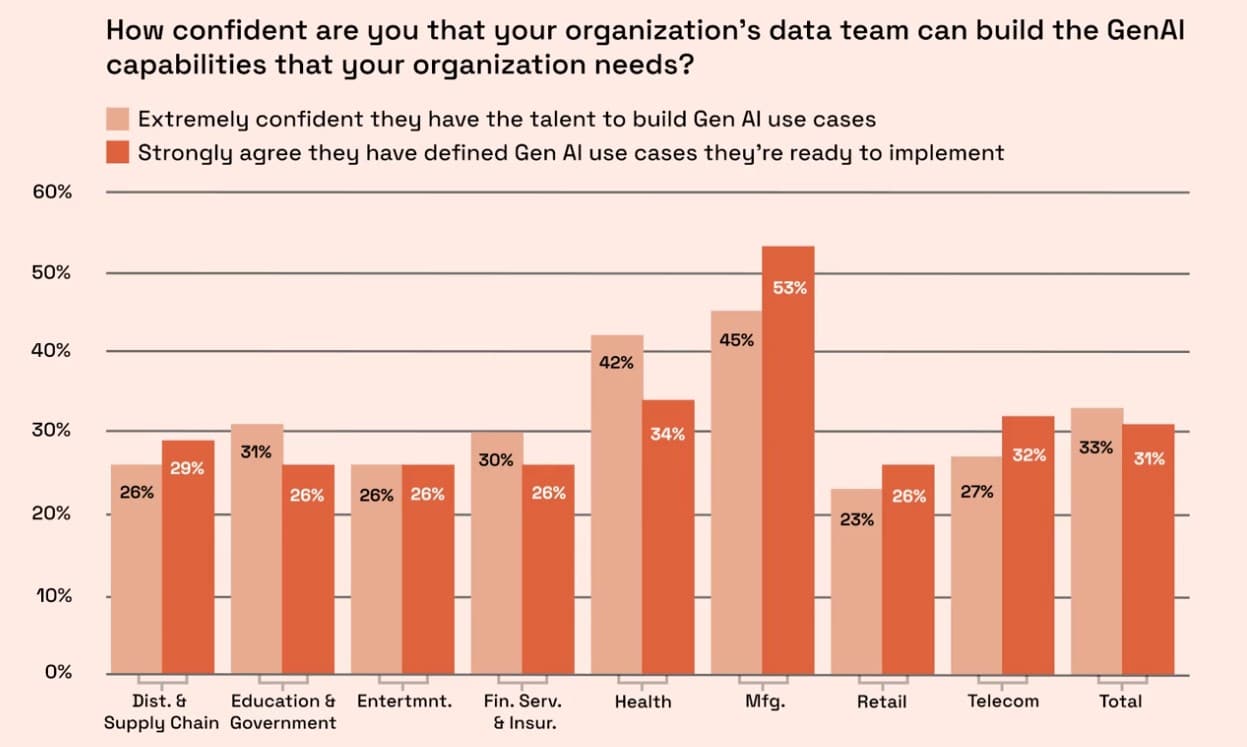As we prepare to move to the next level of Generative AI, new research from cloud data engineering consultancy Hakkoda shows that 50 percent of organizations are already using Gen AI for automation, but sophisticated use cases like AI copilots, ETL/ELT, and schema matching and integration are significantly less common. Results from a survey of 500 data leaders from large organizations across major industries found that the use of AI to automate decision-making was identified as a top challenge for 45 percent of organizations.
According to the firm’s 2024 Generative AI State of Data report, the manufacturing sector is consistently outperforming other industries when it comes to Gen AI deployments. Manufacturing organizations ranked first in nearly every Gen AI application, with high confidence levels in their use cases and internal capabilities to match.

The manufacturing sector is consistently outperforming other industries when it comes to Gen AI deployments. Manufacturing organizations ranked first in nearly every Gen AI application, with high confidence levels in their use cases and internal capabilities to match. With an overall Gen AI deployment rate of 50 percent, manufacturing orgs were also the most likely to be using Gen AI tools for data cleaning and processing (71 percent) and for cataloging (59 percent). Education, government, and healthcare organizations came in behind other industries in their Gen AI deployments and reported the lowest rates of confidence in having implementable Gen AI use cases.

Among the report findings:
- 74 percent of organizations intend to implement a centralized cloud platform in 2024
- 79 percent of organizations indicate the need for a “moderate” to “large” amount of outside help to modernize
- 48 percent of organizations said enabling Gen AI capabilities was a top reason for transitioning to a centralized cloud platform
- 56 percent of the most data-mature organizations have implemented Gen AI use cases
- 32 percent of executives report that they felt “extremely confident” in the ability of their organizations to build necessary Gen AI capabilities internally
A whopping 95 percent of surveyed organizations say Gen AI will be critically important to their success by 2027, and 85 percent expect to have implemented Gen AI tools by the end of 2024.
Additional findings include:
Gen AI Is a top driver of modernization in 2024
Nearly all (94 percent) companies said they need to modernize their data stack. Only 29 percent of organizations report they have transitioned to a centralized data cloud platform and just 42 percent indicate they are already using Gen AI tools. As organizations look to close that gap in 2024, 45 percent of companies plan to begin using a primary cloud platform this year, with another 23 percent predicted to join them in 2025. Only 3 percent of organizations have no plan to make the transition. Of those who had already made the jump to a centralized cloud platform in 2023, 48 percent said enabling Gen AI capabilities was a top reason for transitioning.
Top Gen AI performers are large enough to invest, but small enough to stay agile
$10B organizations demonstrate higher AI usage rates than other orgs, but also report higher rates of dependence on legacy technology. Organizations with less than $500 million in revenue surprisingly reported higher usage rates than much larger companies. Organizations with 10,000 to 24,999 employees represent the sweet spot of AI deployment, outpacing larger and smaller organizations alike with a 49 percent usage rate. These organizations were 33 percent more likely to be deploying Gen AI than their larger peers, leading all organizations of any size in that capacity.

Organizational dissonance is the biggest threat to Gen AI success
Executive and C-level team members were 32 percent more likely to report that they felt “extremely confident” in their internal data teams’ ability to build necessary Gen AI capabilities than lower levels of leadership. Executive and C-level team members were much more likely than lower-level leadership to report that their data teams frequently developed creative ideas for automating processes—a crucial factor to ensure successful implementation of Gen AI tools. Only 4 in 10 organizations strongly agreed that they have the skills and expertise to support the use of Gen AI.
Gen AI tools can build upon consistent ROI on investments
More than half of the most data-mature organizations had already begun using AI tools in 2023, and this year 84 percent of all orgs are set to begin deploying them. Organizations across industries reported an average ROI of 126 percent on data tech investments in 2023—a number that jumped to 164 percent among data-mature orgs. While 50 percent of orgs are already using AI for automation, far fewer are tapping into the potential of more sophisticated functions like AI copilots, ETL/ELT, and schema matching and integration. While companies are more likely to be using AI for automation such as AI-integrated ERP software, applying AI to automate decision-making was a top challenge for 45 percent of organizations in 2023, trailing only data quality and governance.

“The Generative AI State of Data 2024 report shows that the true winners of generative AI will be organizations that take a strategic approach to implementation, investing in both the modernization and the long-term data strategy that will allow their business to radically alter day-to-day operations,” said Erik Duffield, CEO at Hakkoda, in a news release. “A data strategy that aligns everyone from the C-suite to the most granular engineering functions around a clear set of goals, investment requirements, and well-defined obstacles is essential to continuing to grow and expand with generative AI in the years ahead.”
See an executive summary of the report here.
The report was drawn from a study conducted on behalf of Hakkoda by Lawless Research in December 2023 as a blind survey of 500 director to CEO level data leaders from large organizations across major industries. Respondents hold director-level or higher positions in IT and analytics roles at US companies with 1,000 or more employees in the following sectors: Distribution/Supply Chain, Education, Entertainment, Financial Services, Government, Healthcare, Manufacturing, Retail, and Telecommunications. 20 percent of respondents came from organizations with less than $500M annual revenue; 29 percent with $500M to $999.9M annual revenue; 37 percent with $1B to $9.9B annual revenue; 14 percent with $10B or more annual revenue.



